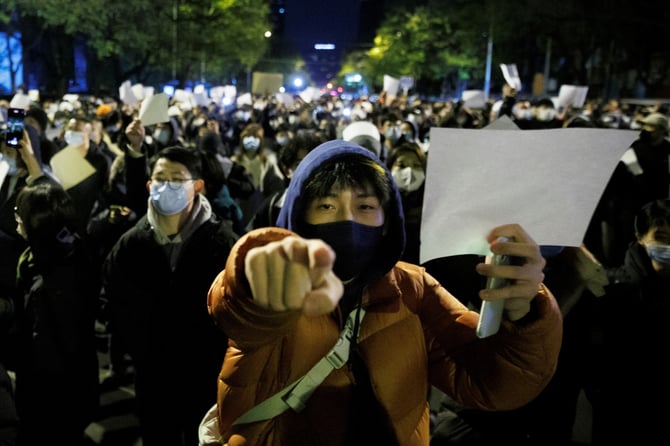China Markets Fall as Protests Flare over COVID Lockdowns

China’s main stock indices and its currency opened the trading week lower on Monday, after significant protests against the country’s harsh COVID-19 restrictions shook investors.
The benchmark Shanghai Composite fell 2.2% in early trading. The Shenzhen Component, a tech index, dropped 1.1%. Hong Kong’s Hang Seng Index tumbled by a marked 4.2%, while the Hang Seng China Enterprises Index, a key index that tracks Chinese companies listed in Hong Kong, slipped 2%.
The Chinese yuan fell against the US dollar. The onshore yuan, active in the restrictive domestic market, briefly lost 0.9%. The offshore rate that trades in foreign markets dropped 0.3%.
The market instability came after protests flared up across China in a rare show of opposition to the country’s increasingly costly Zero-COVID policy. In the country’s financial and administrative hubs of Shanghai and Beijing, residents gathered to call for more freedoms after months of lockdowns have curtailed their business and personal lives while the rest of the world went back to normal.
What does this mean for me?
The flagging yuan suggests that overseas investors are going cold on China, with the currency market one of the surest ways to know what investors think.
Analysts note that there are no easy paths for China. Accelerating reopening plans makes sense, except that there are rising cases of COVID and low vaccination coverage of the elderly. In the near term, Chinese equities and its currency will likely have to price in significant uncertainty
.
The benchmark Shanghai Composite fell 2.2% in early trading. The Shenzhen Component, a tech index, dropped 1.1%. Hong Kong’s Hang Seng Index tumbled by a marked 4.2%, while the Hang Seng China Enterprises Index, a key index that tracks Chinese companies listed in Hong Kong, slipped 2%.
The Chinese yuan fell against the US dollar. The onshore yuan, active in the restrictive domestic market, briefly lost 0.9%. The offshore rate that trades in foreign markets dropped 0.3%.
The market instability came after protests flared up across China in a rare show of opposition to the country’s increasingly costly Zero-COVID policy. In the country’s financial and administrative hubs of Shanghai and Beijing, residents gathered to call for more freedoms after months of lockdowns have curtailed their business and personal lives while the rest of the world went back to normal.
What does this mean for me?
The flagging yuan suggests that overseas investors are going cold on China, with the currency market one of the surest ways to know what investors think.
Analysts note that there are no easy paths for China. Accelerating reopening plans makes sense, except that there are rising cases of COVID and low vaccination coverage of the elderly. In the near term, Chinese equities and its currency will likely have to price in significant uncertainty
.
More News

SoftBank Cashes Out of Nvidia to Double Down on AI Bets
1 week ago

Amazon Rallies 13% as Cloud and AI Power Record Earnings
3 weeks ago

Apple Is Now a $4 Trillion Company
3 weeks ago

UK’s FTSE 100 Hits Record as HSBC Gains Boost Market Confidence
4 weeks ago

Kospi Hits Record as Asian Markets Rally Ahead of Trump–Xi Talks
1 month ago

European Single Stock Exchange Mooted, Even if Execution Will Be Hard
1 month ago

Nestlé Resets With 16,000 Cuts in The Offing
1 month ago

Samsung and SK Hynix Lead Mixed Asian Stocks
1 month ago